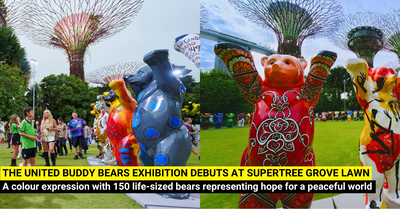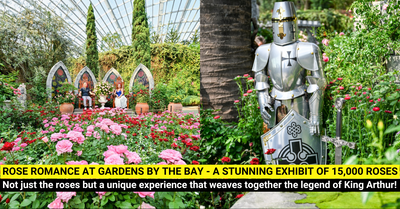From 4 April to 24 May 2023, families can learn more about kebaya as a form of intangible cultural heritage (ICH) and the community stories behind them.

Venue: Various locations
Date: 4 Apr to 24 May 2023
Love, Kebaya Travelling Exhibition
The National Heritage Board (NHB) has launched Love, Kebaya – a new travelling exhibition that highlights the significance of kebaya as the region’s shared cultural identity and living heritage. Kebaya has been submitted as a multinational nomination “Kebaya: Knowledge, Skills, Traditions and Practices” to the UNESCO Representative List of the ICH of Humanity.
Kebaya Created By Craftspersons & Practitioners
The travelling exhibition will kick off at the National Museum of Singapore and travel to various locations around Singapore thereafter. It will feature community contributions, including six kebaya created by kebaya craftspersons and practitioners, and photographs. The photographs show kebaya worn by women of various communities in Singapore, including Malay, Peranakan and Eurasian communities, across different time periods and occasions – as casual wear, at festive occasions and important rites of passage, or as part of traditional performing arts.
Toko Aljunied

- Kebaya
Singapore, 2022
Swiss voile, free-hand embroidery - Sarong (tubular skirt cloth)
Singapore, 2022
Cotton (printed batik)
This forest-green kebaya features embroidered motifs of wild orchids and foliage cascading down the collar and hems of the sleeves. The embroidery of each motif is perforated with rectangular holes, adding a unique touch to the overall design of this kebaya.
The kebaya is paired with a printed batik sarong (tubular skirt cloth), styled with small vertical pleats at the front, known as wiron. A variety of nature-inspired motifs, such as the bird of paradise is featured on the sarong to illustrate the beauty of the natural world. The outfit is completed with a set of kerongsang (brooch).
Operating since the 1930s, Toko Aljunied is one of the longest standing textile businesses in Singapore, best known for their quality batik and tailored garments like kebaya and sarong.
Ratianah Tahir: Kebaya by Ratianah

- Kebaya panjang (long and loose-fitting upper garment)
Singapore, 2023
Bridal satin, gold thread embroidery - Sarong (tubular skirt cloth)
Singapore, 2023
Songket, gold thread embroidery
This flared off-white kebaya panjang berbucu (tapered front end) is customised in bridal satin with floral embroidery outlining the sleeves and front lapel. Kebaya in this material and colour has become a popular choice for bridal wear, reflecting a marriage of classic silhouettes with modern adaptations.
This kebaya is paired with a sarong woven from songket (patterned fabric with gold or silver threads). It is accessorised with a kerongsang (brooch) which consists of a larger central brooch known as the ibu (mother) and two smaller brooches known as the anak (child). The outfit is completed with a sanggul (head dress) and chiffon selendang (long shawl).
Ratianah Tahir, owner of the boutique Kebaya by Ratianah, specialises in making traditional garments such as kebaya and baju kurung (loose-fitting knee-length blouse and long skirt), ranging from bespoke to ready-made pieces. By experimenting with fabrics, colours, and fit, she believes in making kebaya styles accessible to all.
Raymond Wong: Rumah Kim Choo

- Kebaya
Singapore, 2022
Cotton voile, embroidery cutwork and lacework - Sarong (tubular skirt cloth)
Singapore, 2023
Cotton (printed batik)
This lilac-coloured kebaya is decorated with white magnolia and jasmine flower motifs extending across the lower half of the garment, the hems of the sleeves, and the neckline. Swarovski crystals and beads are embellished on top of the floral motifs. With the introduction of sewing machines, the art of sulam which encompasses intricate embroidery and lacework, has become a central feature in the decoration of kebaya since the 1930s.
A dark purple sarong paired with the kebaya is decorated with tulips and koi fish motifs close to the hem, producing a simple yet elegant look for the wearer. The outfit is completed with a kerongsang (brooch) in floral design.
Raymond Wong is a Chinese Peranakan designer and embroiderer known for his craftsmanship in kebaya-making. He is the co-owner of boutique Rumah Kim Choo, where he also conducts classes to teach and promote the craft of Peranakan beadwork and embroidery on kebaya.
Oniatta Effendi: Baju by Oniatta & Galeri Tokokita

-
Kebaya kemben (upper garment with torso-wrap)
Singapore, 2023
Linen, ikat (for the breastcloth panel), cotton (hand-stamped batik for the obi sash) -
Kain panjang (skirt cloth)
Singapore, 2023
Cotton (hand-drawn batik)
This dark blue kebaya kemben is a contemporary look that incorporates the kebaya, and the kemben. The kemben, traditionally known as a breast cloth, is a female torso-wrap made by wrapping a piece of cloth to cover the chest. The kemben may be regarded as an expression of aesthetics, elegance, and femininity. Put together with the kebaya, this design is an ode to women from this side of the Malay-Indonesian world, the Wanita Nusantara.
This kebaya kemben is paired with kain batik tulis (skirt cloth with hand-drawn batik) that has been tailored for ease of the modern wearer. This kain showcases the batik semen rejo motif, which is depicted here with the growth of flora and fauna, accentuated with the stylised wing of the divine mythical creature, Garuda. This batik motif is interpreted as a depiction of life creation, symbolising not only fertility but also spirituality and prosperity.
Founded by Oniatta Effendi, whose grandparents hail from Java, Baju by Oniatta pays homage to her roots and legacy by turning each handmade piece of batik fabric into wearable art. An artiste and drama educator, Oniatta aspires to bring the beauty of the traditions, culture, language and craftsmanship of batik to everyone.
Sufiyanto Amat Sopingi & Muhammad Afiq Juana: kebaya.societé

-
Kebaya saloma
Singapore, 2023
Songket -
Kain panjang (skirt cloth)
Singapore, 2023
Songket
The features and silhouettes of kebaya evolve with changing fashion trends, with some variations omitting front lapels, collars and/or closures altogether.
Popularised in the 1960s, kebaya saloma is a style attributed to Saloma, a Malay Singaporean-Malaysian singer, trendsetter and fashion icon who became well known in the late 1950s. Its distinct style can be identified by its round neckline and back closure. The ruffled sleeves lend a modern feel to the feminine silhouette of kebaya. This contemporary style was a staple in the wardrobe of women in the 1960s.
This red kebaya is paired with a matching kain sempit (long narrow and tapered skirt), delicately sewn in a kipas belakang (back flared) style that features a pleated flounced insert at the back for easier movement. The placement of the insert is usually determined by individual stylistic preferences.
Designer Sufiyanto Amat Sopingi, together with fashion business consultant Muhammad Afiq Juana are the creative forces behind kebaya.societé, an online account that serves as a valuable resource on vintage fashion in the Malay-Indonesian world.
Ratianah Tahir: Kebaya by Ratianah
-
Kebaya kotabaru (upper garment with defining panel collar)
Singapore, 2023
Cotton, embroidery -
Sarong (tubular skirt cloth)
Singapore, 2023
Cotton (printed batik)
This kebaya kotabaru is identified by its additional rectangular-shaped panel collar that connects the front opening of the garment. Made from cotton, it features a peplum silhouette that flares out from the waist, and is adorned with blue, pink and white floral prints. It is complemented by a floral embroidery overlay on the fabric.
This kebaya is paired with a printed batik featuring the parang motif which is believed to symbolise perseverance and strength of good character in the face of hardship. It is styled with small vertical pleats at the front, known as wiron.
Ratianah Tahir, owner of the boutique Kebaya by Ratianah, specialises in making traditional garments such as kebaya and baju kurung (loose-fitting knee-length blouse and long skirt), ranging from bespoke to ready-made pieces. By experimenting with fabrics, colours, and fit, she believes in making kebaya styles accessible to all.
NOTE: The kebaya displayed at the travelling exhibitions are subject to rotation.
Travelling Exhibition Schedule
- National Museum of Singapore, The Platform, Level 2
- 4 to 23 Apr 2023
- Gardens by the Bay, Visitor Services Centre
- 26 Apr to 14 May 2023
- Our Tampines Hub Festive Market
- 16 to 24 May 2023






![30+ Of The Best Kid-friendly Museums And Exhibition in Singapore For All Ages [2025 UPDATED]](http://www.bykido.com/cdn/shop/articles/c2b80d63041615fedc7f3b0047c2c6b4_520x500_520x500_19113881-0300-4997-840a-e1018c34aa5a_400x.webp?v=1765950472)
